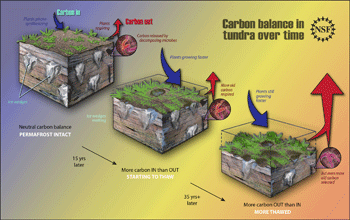Multimedia Gallery
Carbon Balance in Tundra (Image 1)
A lot of old carbon is stored deep in the tundra, where it is locked in permafrost. As these areas start to thaw over about 15 years, large ice wedges in the soil get smaller, causing pot-holing and soil depression. The newly available water prompts faster plant growth, and the carbon taken out of the atmosphere by the plants photosynthesizing is greater than the carbon released back into the atmosphere by plants respiring and microbes decomposing carbon. However, after about 50 years, as thawing continues and the soil settles even more, plants are growing faster yet, however the rate of plant respiration and old carbon release through microbes grows even bigger netting more carbon out into the atmosphere than into the soil.
This image accompanied NSF press release, "Arctic Tundra May Contribute to Warmer World." [See related image Here.]
Credit: Zina Deretsky, National Science Foundation
Images and other media in the National Science Foundation Multimedia Gallery are available for use in print and electronic material by NSF employees, members of the media, university staff, teachers and the general public. All media in the gallery are intended for personal, educational and nonprofit/non-commercial use only.
Images credited to the National Science Foundation, a federal agency, are in the public domain. The images were created by employees of the United States Government as part of their official duties or prepared by contractors as "works for hire" for NSF. You may freely use NSF-credited images and, at your discretion, credit NSF with a "Courtesy: National Science Foundation" notation.
Additional information about general usage can be found in Conditions.
Also Available:
Download the high-resolution JPG version of the image. (595 KB)
Use your mouse to right-click (Mac users may need to Ctrl-click) the link above and choose the option that will save the file or target to your computer.

